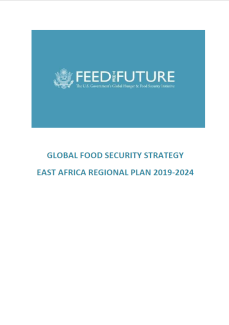Food insecurity remains a persistent problem in East Africa (EA), despite the fact that the region produces enough food to feed itself. This points to one of the biggest challenges facing East Africa: the inability to move food from surplus to food deficit areas, often due to cross border trade barriers. To address this challenge, USAID Kenya/East Africa (USAID/KEA) has supported a variety of food security and trade efforts over the past two decades. Since 2011, USAID/KEA supported these efforts through Feed the Future East Africa (Feed the Future-EA), the mission’s primary means to implement the United States Government Global Food Security Strategy (GFSS). The purpose of the East Africa Regional Plan 2019-2024 (EA Regional Plan) is to articulate how the next phase of Feed the Future-EA will continue to contribute to GFSS objectives and the region’s Journey to Self-Reliance (J2SR).
To inform the EA Regional Plan, USAID/KEA consulted with a broad range of stakeholders, including private-sector companies, non-governmental organizations, implementers, regional economic communities, and private-sector and civil society associations. In addition, USAID/KEA incorporated key lessons learned from independent evaluations of past regional development activities. The EA Regional Plan builds on this feedback and achievements to date, while identifying remaining development challenges, gaps and opportunities. Further, this plan leverages the strengths of USAID bilateral missions and U.S. Government (USG) interagency partners representing a whole-of-government approach to achieving GFSS objectives.
The next phase of Feed the Future-EA will focus on three areas: 1) inclusive and sustainable agricultural-led economic growth; 2) strengthened resilience among people and systems; and 3) a well-nourished population, especially women and children. Feed the Future-EA will build the capacity of national and regional stakeholders, including the private sector, to ease the movement of food across borders, while also addressing other impediments to agricultural growth, resilience and nutrition in the region. This plan pivots from an earlier emphasis on policy harmonization to a greater emphasis on private sector partnerships, which aligns with USAID’s Private Sector Engagement Strategy and the Prosper Africa initiative, as a means of empowering people and countries on their journey to self-reliance. Consequently, the next phase of Feed the Future-EA will have greater focus on implementation of activities that deliver concrete, practical solutions to regional food security challenges.
The EA Regional Plan also recognizes the comparative advantages that the USAID/KEA regional office provides in addressing the opportunities for improved food security in East Africa. Many of the constraints in East Africa are transboundary in nature, such as climate variability, pests and diseases or cross border barriers to trade. The USAID/KEA regional office offers a unique platform to convene stakeholders across national boundaries, while leveraging the authority of regional bodies, to address these challenges and ensure that East Africa transforms to a food secure region.
Budget assumptions for interagency contributions to this plan reflect the Fiscal Year (FY) 2017 Estimate and FY2018 President's Budget, based on information publicly available at the time this document was prepared. Future year budget assumptions reflect a straight-line to the FY2018 President's Budget. Any funding beyond FY2017 is subject to the availability of funds, as determined by the President's Budget and Congressional appropriations, and as such, budget assumptions may require revision.

